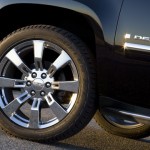 Thinking of changing the tires out on your Silverado or Yukon for some over sized off-road tires or maybe switching to some 20’s or bigger on your Trailblazer or Suburban? Something to consider is how it will affect your speedometer reading, read this great article to understand what affect your change in wheel/tire size will have on your instrument cluster.
Thinking of changing the tires out on your Silverado or Yukon for some over sized off-road tires or maybe switching to some 20’s or bigger on your Trailblazer or Suburban? Something to consider is how it will affect your speedometer reading, read this great article to understand what affect your change in wheel/tire size will have on your instrument cluster.
Speedometer Accuracy
No speedometer can be 100 percent accurate. In fact, most manufacturers build speedometers so they fall within a fairly narrow tolerance range, no more than 1 percent to 5 percent too slow or too fast. As long as a car is maintained at factory specs, its speedometer should continue to register vehicle speed within this range. But, if a car is modified, its speedometer may need to be recalibrated.
Changing tire size is one of the most common things car owners do that can affect speedometer accuracy. That’s because larger tires cover more ground in one complete revolution. Consider the example below.
Your car comes with factory-installed tires that are 21.8 inches in diameter. That means the circumference of each tire is 68.5 inches. Now let’s say you want to replace the stock tires with new tires that are 24.6 inches in diameter. Each new tire has a circumference of 77.3 inches, which means it travels almost 10 inches farther with each complete revolution. This has a tremendous affect on your speedometer, which will now indicate a speed that is too slow by almost 13 percent. When your speedometer reads 60 miles per hour, your car will actually be traveling 67.7 miles per hour!
Speedometer Calibration
All speedometers must be calibrated to make sure the torque created by the magnetic field accurately reflects the speed of the car. This calibration must take into account several factors, including the ratios of the gears in the drive cable, the final drive ratio in the differential and the diameter of the tires. All of these factors affect the overall speed of the vehicle. Take tire size, for example. When an axle makes one complete turn, the tire it’s connected to makes one complete revolution. But a tire with a larger diameter will travel farther than a wheel with a smaller diameter. That’s because the distance a tire covers in one revolution is equal to its circumference. So a tire with a diameter of 20 inches will cover about 62.8 inches of ground in one revolution. A tire with a diameter of 30 inches will cover more ground — about 94.2 inches.
Calibration adjusts for these variances and is done by the manufacturer, which sets up the speedometer gear to correspond with the factory-installed ring and pinion ratio and tire size. A car owner may have to recalibrate his speedometer if he makes changes that make his vehicle fall out of factory specifications (see the sidebar below). Recalibrating a speedometer can be done by manipulating the hairspring, the permanent magnet or both. Generally, the strength of the magnetic field is the easiest variable to change. This requires a powerful electromagnet, which can be used to adjust the strength of the permanent magnet in the speedometer until the needle matches the input from the rotating drive cable.
Harris, William. “How Speedometers Work” 10 July 2007. HowStuffWorks.com. <http://auto.howstuffworks.com/car-driving-safety/safety-regulatory-devices/speedometer.htm> 09 September 2010.
If you are in need of instrument cluster repair for any GM vehicle made between 2003 and 2006 contact Dr.Speedometer at http;//drspeedometer.com
